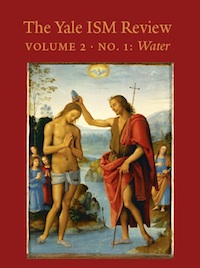Don E. Saliers
Many years ago, when I was a young boy, I visited a hydroelectric plant beneath a large concrete dam. Outside, the roaring flow of water was impressive; inside, the whine and hum of generators intense. It was amazing, actually, that water flooding a maze of pipes and turbines could release electrical power to so many places, supplying myriad households with energy. I remember thinking, “This is miraculous.”
Then and there the idea of water becoming something immaterial was etched in my grade-school brain. Yes, there were other transformations of water I knew about: snow, ice, rain, vapor, steam; but the thought of a flow of water generating invisible power . . . that was something else.
Much later, when biblical images of water fired my imagination, I began to ponder how water-transformed-into-seemingly-invisible-energy provides analogies with ways Christians talk about the work of the Holy Spirit. In some churches people speak about how the Spirit is “flowing through them.” This was especially so in evangelical Wednesday night prayer services for which I often played piano to accompany the singing. Uncle Frank, as everyone called the preacher, would always intone some formula in his “Spirit-led” prayer like “Lord, let the Spirit come into our hearts and flood our lives!” We would sing, “Come, thou fount of every blessing, tune my heart to sing thy praise,” or sometimes,
“. . . when peace like a river . . .” Images of flowing rivers and floods of blessing shaped that singing community, coursing through our emotionally charged prayers. Some nights were “electric”; the whole assembly came alive.
Yet that was only one aspect of the root metaphor connecting water with Holy Spirit talk. I also recall singing Psalm 42 on a church retreat and hearing, as if for the first time, a more gentle connection. “As the deer longs for living water, so my soul longs for you, O God.” Thirst for God emerged as a plea for the life-giving quality of divine presence. This, too, concerns power: the power to live and embrace life, even when our hearts are cast down and disquieted. In this instance, the flow of the Spirit is more subtle and complex than can be pictured as some inner electricity or episodic sensation. The Spirit has also to do with the transformation of time and memory (as in Psalm 42/43).
When theological questions about Baptism and the Church became a focal point for me in seminary, I moved into further explorations of water by discovering a primary ritual place for the linkage between water and the Spirit. In the baptismal act (which can appear so mechanical at times!) our liturgies claim the release of divine power generated “by water and the Spirit.” The Word and prayer of the Church come to the sign of water, making real and powerful the promises of God. What kind of power is this? As once was said, “The waters of Baptism have loosed the foundations of empire.” Yes, baptismal waters can shake an empire, but they begin as a generating current in the community of faith itself. It gradually dawned on me that the renewal of the baptismal covenant—especially at the Easter Vigil—is a surging source of prophetic self-critique. It creates a current of reform and renewal.
When the 1979 Book of Common Prayer placed rites of Baptism at the beginning of the prayer book, it signaled a major shift in pneumatology. Christian Initiation signals the primacy of water and Spirit: the enSpirited release of an unfailing source of life-giving power that we call “grace.” The sacramentality of water is both Spirit-dependent and Spirit-mediating. All these images deepen over time: the outpouring of divine energies seeks release in and through the humble, yet astounding, polyvalence of water.
The Ecstatic Life of God is poured into the world. Gather we then about living waters of font or baptismal pool. “Shall we gather at the river . . . ” was sung at those prayer meetings and in cathedrals and meeting houses, inviting us to the bath and to the New Creation itself. Here we discover that a central work of the Spirit is to place us in company with saints and angels. We are gathered by what the Eastern traditions have referred to as the “uncreated energies of God.”
In a fit of whimsy it occurs to me that Baptism has to do with divine hydro-pneumatics. This is not to be confused with our having a mechanism that guarantees the presence and power of the Holy Spirit. The power of the Spirit is, rather, sheer gift like a flowing stream, a sudden storm—an unbidden life force. Could it be, after all is said and done, that the Divine Ecstasy is nothing less than the delight God takes in animating human existence and the whole created order by the transforming power of the Holy Spirit? If so, then the whole of baptismal life might be called, in a fit of theological whimsy, a hydro-pneumatic ecstasy.
Herein the personal, the social, and the cosmic work of God the Holy Spirit are bound together. We sing “For All the Saints” by the font and fire of the Paschal candle. And when we get to that final stanza—“from earth’s wide bounds . . . streams in the countless host . . . singing to Father, Son and Holy Ghost: Alleluia!”—it is electric!
 Don E. Saliers is Cannon Distinguished Professor Emeritus of Theology and Liturgy at Emory University. He has served as president of the North American Academy of Liturgy and the Society for Christian Spirituality. Among his many publications are Worship As Theology and A Song to Sing; with his daughter Emily Saliers he coauthored A Life to Live. An active musician, he is organist/choirmaster at Emory’s Cannon Chapel, and teaches in the summer sessions at the Yale Institute for Sacred Music, as well as leading seminars and retreats.
Don E. Saliers is Cannon Distinguished Professor Emeritus of Theology and Liturgy at Emory University. He has served as president of the North American Academy of Liturgy and the Society for Christian Spirituality. Among his many publications are Worship As Theology and A Song to Sing; with his daughter Emily Saliers he coauthored A Life to Live. An active musician, he is organist/choirmaster at Emory’s Cannon Chapel, and teaches in the summer sessions at the Yale Institute for Sacred Music, as well as leading seminars and retreats.
